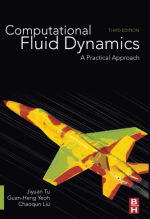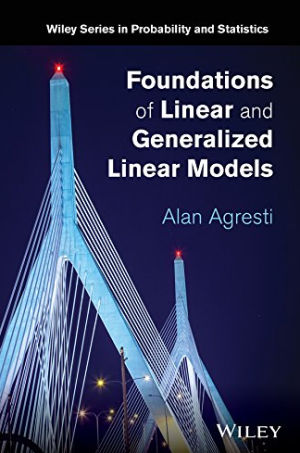Computational Fluid Dynamics: A Practical Approach 3rd Edition by Jiyuan Tu, ISBN-13: 978-0081011270
[PDF eBook eTextbook]
498 pages
Publisher: Butterworth-Heinemann; 3 edition (February 9, 2018)
Language: English
ISBN-10: 008101127X
ISBN-13: 978-0081011270
Computational Fluid Dynamics: A Practical Approach, Third Edition, is an introduction to CFD fundamentals and commercial CFD software to solve engineering problems. The book is designed for a wide variety of engineering students new to CFD, and for practicing engineers learning CFD for the first time. Combining an appropriate level of mathematical background, worked examples, computer screen shots, and step-by-step processes, this book walks the reader through modeling and computing, as well as interpreting CFD results. This new edition has been updated throughout, with new content and improved figures, examples and problems.
– Includes a new chapter on practical guidelines for mesh generation
– Provides full coverage of high-pressure fluid dynamics and the meshless approach to provide a broader overview of the application areas where CFD can be used
Table of contents:
Cover……Page 1
Half Title……Page 2
Computational Fluid Dynamics:
A Practical Approach……Page 3
Copyright……Page 4
Preface for Third Edition……Page 5
Preface for Second Edition……Page 6
Preface for First Edition……Page 7
Acknowledgements……Page 10
What is Computational Fluid Dynamics……Page 11
Advantages of Computational Fluid Dynamics……Page 14
As a Research Tool……Page 16
As an Educational Tool……Page 17
As a Design Tool……Page 18
Aerospace……Page 19
Automotive Engineering……Page 20
Biomedical Science and Engineering……Page 22
Chemical and Mineral Processing……Page 25
Civil and Environmental Engineering……Page 27
Metallurgy……Page 29
Nuclear Safety……Page 30
Power Generation and Renewable Energy……Page 32
Sports……Page 35
The Future of Computational Fluid Dynamics……Page 37
Summary……Page 39
Review Questions……Page 40
Introduction……Page 42
Shareware CFD……Page 43
Commercial CFD……Page 44
Creation of Geometry-Step 1……Page 45
Mesh Generation-Step 2……Page 48
Selection of Physics and Fluid Properties-Step 3……Page 49
Specification of Boundary Conditions-Step 4……Page 51
Initialization and Solution Control-Step 5……Page 55
Monitoring Convergence-Step 6……Page 57
Result Report and Visualization-Postprocess……Page 60
X-Y Plots……Page 62
Vector Plots……Page 63
Contour Plots……Page 65
Other Plots……Page 67
Data Report and Output……Page 68
Animation……Page 69
Summary……Page 70
Review Questions……Page 71
Mass Conservation……Page 73
Physical Interpretation……Page 77
Comments……Page 80
Force Balance……Page 81
Physical Interpretation……Page 85
Comments……Page 95
Energy Conservation……Page 96
Physical Interpretation……Page 99
Comments……Page 105
What is Turbulence……Page 106
k- Two-Equation Turbulence Model……Page 108
Generic Form of the Governing Equations for CFD……Page 116
Physical Boundary Conditions of the Governing Equations……Page 125
Summary……Page 128
Review Questions……Page 129
Introduction……Page 133
Structured Mesh……Page 135
Body-Fitted Mesh……Page 136
Unstructured Mesh……Page 141
Comments on Mesh Topology……Page 144
Local Mesh Refinement……Page 148
Overlapping Mesh Techniques……Page 152
Adaptive Mesh With Solution……Page 153
Moving Meshes……Page 154
Guidelines for Mesh Quality and Mesh Design……Page 156
Review Questions……Page 160
Introduction……Page 163
Finite Difference Method……Page 166
Finite Volume Method……Page 171
Finite Element Method……Page 176
Converting Governing Equations to Algebraic Equation System……Page 177
Finite Difference Method……Page 178
Finite Volume Method……Page 179
Comparison of the Finite Difference and Finite Volume Discretizations……Page 181
Numerical Solutions to Algebraic Equations……Page 192
Direct Methods……Page 193
Iterative Methods……Page 197
Pressure-Velocity Coupling-Simple Scheme……Page 201
Multigrid Method……Page 212
Summary……Page 214
Review Questions……Page 215
Introduction……Page 219
Consistency……Page 220
Stability……Page 224
What is Convergence……Page 230
Residuals and Convergence Tolerance……Page 232
Convergence Difficulty and Using Under-Relaxation……Page 235
Accelerating Convergence……Page 236
Accuracy……Page 237
Source of Solution Errors……Page 238
Discretisation Error……Page 239
Round-Off Error……Page 242
Physical Modelling Error……Page 243
Controlling the Solution Errors……Page 244
Verification and Validation……Page 246
Efficiency……Page 247
Case Studies……Page 249
Test Case A: Channel Flow……Page 250
Test Case B: Flow over a 90o Bend……Page 253
Summary……Page 258
Review Questions……Page 259
Introduction……Page 262
Overview of Setting Boundary Conditions……Page 263
Guidelines for Inlet Boundary Conditions……Page 265
Guidelines for Outlet Boundary Conditions……Page 267
Guidelines for Wall Boundary Conditions……Page 268
Guidelines on Symmetry and Periodic Boundary Conditions……Page 269
Advanced Techniques……Page 271
Practical Techniques……Page 272
Guideline on a Particular Weakness of the Standard k- Model……Page 274
Other Useful Guidelines……Page 279
Near Wall Treatments……Page 280
Near-Wall Meshing Guidelines on Wall Functions……Page 283
Setting Boundary Conditions……Page 284
Test Case: Assessment of Two-Equation Turbulence Modeling for Hydrofoil Flows……Page 286
Features of the Simulation……Page 287
Boundary Conditions……Page 288
Results……Page 289
Guidelines on Problem Definition……Page 291
Guidelines on Solution Strategy and Global Solution Algorithm……Page 292
Summary……Page 293
Review Questions……Page 295
Introduction……Page 298
Indoor Airflow Distribution……Page 299
To Enhance Understanding-As a Research Tool……Page 305
Gas-Particle Flow in a 90 degrees Bend……Page 306
Governing Equations of Particle Phase Using the Lagrangian Approach……Page 307
Governing Equations of Particle Phase Using the Eulerian Approach……Page 308
Heat Exchanger……Page 312
Conjugate and Radiation Heat Transfer……Page 319
A Buoyant Free-Standing Fire……Page 327
Flow Over Vehicle Platoon……Page 332
Air/Particle Flow in the Human Nasal Cavity……Page 338
Supersonic Flow Over a Flat Plate……Page 345
Subsonic and Supersonic Flows Over a Wing……Page 355
Summary……Page 368
Review Questions……Page 369
Incompressible Flows……Page 375
Compressible Flows……Page 379
High Resolution Schemes……Page 380
Adaptive Meshing……Page 384
Moving Grids……Page 386
Multigrid Methods……Page 387
Parallel Computing……Page 390
Graphics Processing Units and CUDA Environment……Page 391
Immersed Boundary Methods……Page 393
Direct Numerical Simulation (DNS)……Page 396
Large Eddy Simulation (LES)……Page 399
RANS-LES Coupling for Turbulent Flows……Page 402
Multiphase Flows……Page 404
Combustion……Page 406
Fluid-Structure Interaction……Page 408
Physiological Fluid Dynamics……Page 410
Other Numerical Approaches for Computation of Fluid Dynamics……Page 412
Lattice Boltzmann Method……Page 413
Monte Carlo Method……Page 415
Particle Methods……Page 417
Discrete Element Method……Page 419
Summary……Page 421
Review Questions……Page 422
Introduction……Page 424
Simulation……Page 425
CFD Results and Discussion……Page 427
Simulation……Page 437
CFD Results and Discussion……Page 441
Case Introduction……Page 465
Simulation……Page 466
CFD Results and Discussion……Page 470
Case Introduction……Page 476
CFD Simulation……Page 477
CFD Results and Discussion……Page 481
Case Introduction……Page 484
Simulation……Page 485
CFD Results and Discussion……Page 487
Post Processing the Results……Page 488
Problem Description……Page 490
CFD Simulations……Page 491
Results and Discussion……Page 493
Problem Description……Page 496
Simulation……Page 497
Results and Discussion……Page 500
Case Introduction……Page 503
Simulation……Page 504
CFD Results and Discussion……Page 507
Case Introduction……Page 510
Simulation……Page 511
CFD Results and Discussion……Page 514
Case Introduction……Page 517
Problem Description……Page 518
Simulation……Page 519
CFD Results and Discussion……Page 520
Case Introduction……Page 527
Problem Description……Page 528
CFD Simulation……Page 529
CFD Results and Discussion……Page 532
Flow and Heat Mass Transfer in Shell-and-Tube Heat Exchanger……Page 538
Numerical Simulation……Page 539
CFD Results and Discussion……Page 541
Appendix A
Full Derivation of Conservation Equations……Page 546
Appendix B
Upwind Schemes……Page 553
Appendix C
Explicit and Implicit Methods……Page 555
Appendix D
Learning Program……Page 557
Problem Description……Page 560
Instructions……Page 561
Single Car Configuration……Page 562
Instructions……Page 563
Background and Aim……Page 564
Problem Description……Page 565
Instructions……Page 566
Objectives……Page 567
Introduction……Page 568
Objectives……Page 569
Required Discussions……Page 570
Required Discussions……Page 571
Addendum……Page 572
Problem Description……Page 573
Required Discussions……Page 574
References……Page 575
Further Reading……Page 589
B……Page 590
C……Page 591
D……Page 592
F……Page 593
G……Page 594
H……Page 595
L……Page 596
P……Page 597
S……Page 598
T……Page 599
Z……Page 600
Back Cover……Page 601
What makes us different?
• Instant Download
• Always Competitive Pricing
• 100% Privacy
• FREE Sample Available
• 24-7 LIVE Customer Support









Reviews
There are no reviews yet.